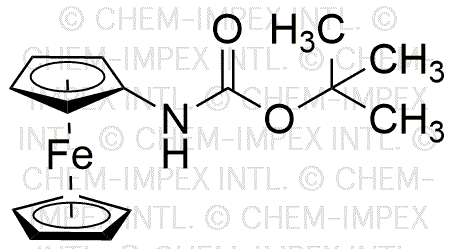N-(tert-Butoxycarbonyl)aminoferrocene is widely utilized in research focused on:
- Organic Synthesis: This compound serves as a versatile building block in the synthesis of various organic molecules, particularly in the development of new pharmaceuticals.
- Electrochemistry: Its unique ferrocene structure allows for applications in electrochemical sensors, enhancing the detection of biomolecules and environmental pollutants.
- Materials Science: Used in the creation of advanced materials, it contributes to the development of conductive polymers and nanocomposites, which are essential in electronics.
- Catalysis: This compound acts as a catalyst in several chemical reactions, improving reaction rates and selectivity, which is crucial in industrial processes.
- Biomedical Applications: Its properties make it suitable for drug delivery systems, where it can enhance the solubility and stability of therapeutic agents.
General Information
Properties
Safety and Regulations
Applications
N-(tert-Butoxycarbonyl)aminoferrocene is widely utilized in research focused on:
- Organic Synthesis: This compound serves as a versatile building block in the synthesis of various organic molecules, particularly in the development of new pharmaceuticals.
- Electrochemistry: Its unique ferrocene structure allows for applications in electrochemical sensors, enhancing the detection of biomolecules and environmental pollutants.
- Materials Science: Used in the creation of advanced materials, it contributes to the development of conductive polymers and nanocomposites, which are essential in electronics.
- Catalysis: This compound acts as a catalyst in several chemical reactions, improving reaction rates and selectivity, which is crucial in industrial processes.
- Biomedical Applications: Its properties make it suitable for drug delivery systems, where it can enhance the solubility and stability of therapeutic agents.
Documents
Safety Data Sheets (SDS)
The SDS provides comprehensive safety information on handling, storage, and disposal of the product.
Product Specification (PS)
The PS provides a comprehensive breakdown of the product’s properties, including chemical composition, physical state, purity, and storage requirements. It also details acceptable quality ranges and the product's intended applications.
Certificates of Analysis (COA)
Search for Certificates of Analysis (COA) by entering the products Lot Number. Lot and Batch Numbers can be found on a product’s label following the words ‘Lot’ or ‘Batch’.
*Catalog Number
*Lot Number
Certificates Of Origin (COO)
This COO confirms the country where the product was manufactured, and also details the materials and components used in it and whether it is derived from natural, synthetic, or other specific sources. This certificate may be required for customs, trade, and regulatory compliance.
*Catalog Number
*Lot Number
Safety Data Sheets (SDS)
The SDS provides comprehensive safety information on handling, storage, and disposal of the product.
DownloadProduct Specification (PS)
The PS provides a comprehensive breakdown of the product’s properties, including chemical composition, physical state, purity, and storage requirements. It also details acceptable quality ranges and the product's intended applications.
DownloadCertificates of Analysis (COA)
Search for Certificates of Analysis (COA) by entering the products Lot Number. Lot and Batch Numbers can be found on a product’s label following the words ‘Lot’ or ‘Batch’.
*Catalog Number
*Lot Number
Certificates Of Origin (COO)
This COO confirms the country where the product was manufactured, and also details the materials and components used in it and whether it is derived from natural, synthetic, or other specific sources. This certificate may be required for customs, trade, and regulatory compliance.
*Catalog Number
*Lot Number
Citations
Sign up and save
Entice customers to sign up for your mailing list with discounts or exclusive offers.


